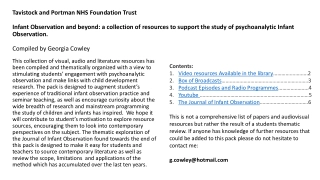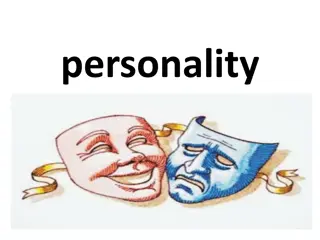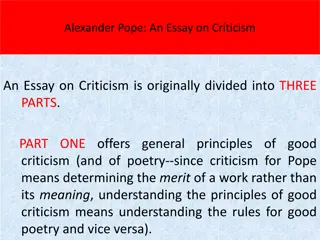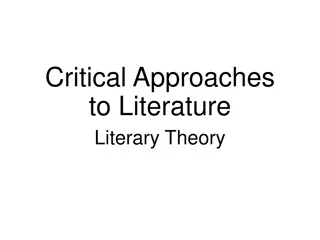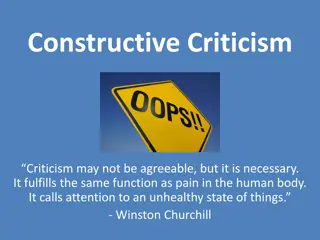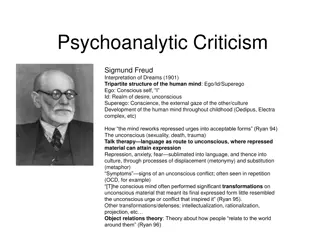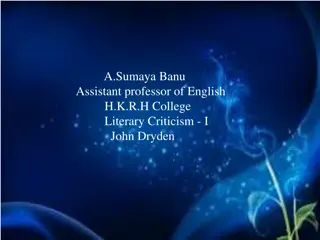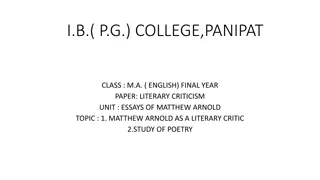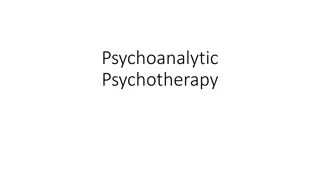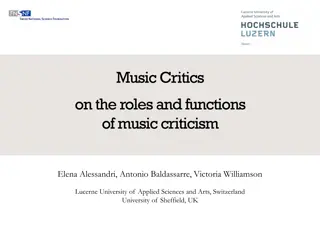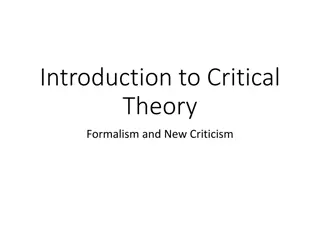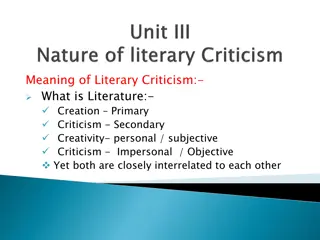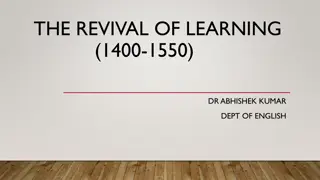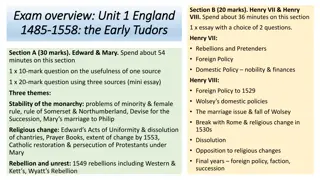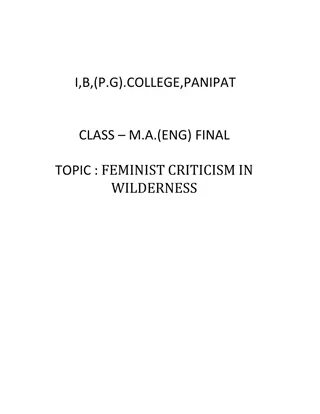Exploring Different Perspectives on Henry IV, Part 1 Through Myth, Psychoanalytic, New Criticism, and New Historicist Criticism
Delve into various critical lenses such as myth, psychoanalytic, New Criticism, and New Historicist Criticism to analyze Henry IV, Part 1. Uncover the mythic origins of characters like Falstaff, connections to ancient rituals, and the symbolism of killing the king. Discover how literature intertwines with cultural practices and societal narratives in understanding Shakespeare's work.
Download Presentation

Please find below an Image/Link to download the presentation.
The content on the website is provided AS IS for your information and personal use only. It may not be sold, licensed, or shared on other websites without obtaining consent from the author. Download presentation by click this link. If you encounter any issues during the download, it is possible that the publisher has removed the file from their server.
E N D
Presentation Transcript
4 WAYS OF LOOKING AT HENRY IV, PART 1 MYTH, PSYCHOANALYTIC, NEW CRITICISM, AND NEW HISTORICIST CRITICISM
MYTHIC ORIGINS OF CHARACTERS LIKE FALSTAFF Myth criticism assumes that drama is linked to tribal rituals through vestiges such as Falstaff, whose character is drawn from the Roman comedy miles gloriosus Miles Gloriosus, also called the Braggart Warrior, is a stock figure originally from a play written in about 205 BC.Miles Gloriosus is a vain, lustful, and stupid soldier, is duped by his clever slave and a courtesan.
AND THE MORALITY PLAY VICE (GLUTTONY)
AND FARTHER BACK BACCHUS/ DIONYSUS AND MAGIC
MYTH CRITICS The best known practitioners are Northrop Frye (Anatomy of Criticism and many essays on Shakespeare) and C.L. Barber (Shakespeare's Festive Comedy). The assumption is that literature is not just very special words on a page, but is in a continuum with the oldest tribal rituals, and that literature is a cultural practice of our society in which we tell ourselves as a community who we are, partly by telling ourselves what we were. Thus, relevant to history plays.
J. I. M. STEWART Falstaff harks back to the ancient English fertility rituals in which one person got to be King for the year, and then would be killed at the Winter Solstice to bring fertility in for the new year. In "countries gone waste and barren under the rule of an old, impotent, and guilty king, who must be ritually slain and supplanted by his son or another before the saving rains come, bringing purification and regeneration."
KILLING THE KING The King figures in these rituals were killed and eaten, and then a new one was inaugurated. But you don't kill the REAL king in H IV (argues Stewart). Instead, you kill the ritual king, the one who closely resembles Dionysus (and even Santa Claus for the Winter Solstice). This makes the parallel between Falstaff and Bolingbroke (Henry IV) very important. "Falstaff, in standing for the old king, symbolizes all the accumulated sin of the reign, all the consequent sterility of the land. But the young king draws his knife at the altar and kills Falstaff -- by rejecting him in Part 2.
CALL IN RIBS, CALL IN TALLOW In Henry V, Mistress Quickly says, "The King has killed his heart" as Falstaff lies dying. And Falstaff has been represented as somebody worth eating, he's compared to a whole larder of "fat meat." "Call in Ribs, call in Tallow" is the cue for Falstaff to enter. He's a great big roast. So do we say that this rejection (and consumption) makes it possible for a new "pure and regenerated" king to take over and bring fertility to England?
WE SEE OURSELVES IN THE PLAY According to myth criticism, we see ourselves in the mirror of the play. We see ourselves as Hal who needs to redeem himself, We see in ourselves a little Hotspur who needs to ask for help and slow down, We are Falstaff when we indulge too much. Hal is then a folk hero. [Read 4.1.104--]
PSYCHOANALYTIC Practitioners started with Sigmund Freud, then at Berkeley Coppelia Kahn, in Paris Jacques Lacan, Melanie Klein, Luce Irigaray, Jane Gallop (Minnesota), etc. Emphasis on Characters and settings representing Id, Ego, SuperEgo Roughly equivalent to an internal child, adult and parent Return of the Repressed Nothing can be repressed forever; it will come out in one way or another Oedipus complexes (Electra complexes) Childhood trauma, usually before 6, sometimes adolescence
HOW IT WORKS: Franz Alexander: "Falstaff's hedonism represents the uninhibited gratification of an infantile and narcissistic quest for pleasure, a craving alive in all of us" (representing the ID, and a foil for Hal) vs. Guilt of the King that overshadowed his own life and Hal's (representing the superego punishment that Hal must keep at a distance) The tragic guilt of high people: on Henry IV's deathbed, he says: How I came by the crown, O God forgive;/And grant it may with thee in true peace live!
FATHER STRUGGLE [CONTINUED FROM ALEXANDER] "Prince Hal's struggle against his father appears in isolation (no sleeping with mother), enacted in male society. The defenses which Prince Hal mobilizes in order to escape from his internal predicament are well known from the clinical studies of male youths, who see a faulty father figure, and therefore mirror back to the king the King's moral depravity. Hal mirrors back the King's depravity to him, and also acquires a substitute antithesis of Father in Falstaff. Then the Prince triumphs over both the Father and the Father substitute.
NEW CRITICISM Main practitioners are T.S. Eliot, A.I. Richards, Cleanth Brooks, and Robert Penn Warren. There is a special concern with metaphor and language, along with emphasis on paradox and irony. A work of art is perfection in itself. Don't look at myths to which the literature is connected or other works written the same year or the author's life, or the historical conditions -- JUST EXAMINE THE TEXT!
3 WAYS A. Trace a set of images through a text or B. Look at one passage extremely closely (start with a short passage and examine it) or C. Look for irony and paradox within a text (this will eventually become deconstruction)
EXAMPLE IN HENRY IV, PART 1 Example: New Criticism works with the sun images or disease images that pervade Henry IV or Take a passage like Hal's early soliloquy and see how that speech is a KEY to the whole play (images used, why he says it, how it connects to other speeches and unifies the play) Unity is important. To a true new critic, every single detail, every character, and every line is a sign of the perfection of the text. You worship it.
CONTENT GOES WITH FORM Look at the connection between the Content and the Form. You might look at this play as a System of Contrasts. A New Critic would do this while pointing to the perfection and unity of the play. Cleanth Brooks and Robert Heilman argue, for example, that the play is perfectly unified and IRONIC.
FALSTAFF Example: R. J. Dorius develops the themes of good husbandry vs. extravagance through the metaphoric language of the whole 4-play sequence. He connects the language to the idea that LIFE and POWER are precious gifts and that to squander them or misdirect them is a crime against God and the state. [You might connect this to the Great Chain of Being, too -- something which New Critics like].
DORIUS ON FAT AND THIN He uses the idea of skinny Henry IV (Bolingbroke) literally worn away with anxiety as opposed to the fat King of the Revels (Falstaff). Words like: "Pharaoh's lean kine" (7 years of famine, not 7 years of plenty) "The merry word games in which the Prince and Falstaff engage, the matchings of 'unsavory similes' of fatness and thinness, represent a comic playing with political and moral themes at the core of these plays."
BANISH ALL THE WORLD Then Dorius centers his analysis upon 3 or 4 critical passages (typical New Critical move). 1. the dialogue between H-4 and Hal Richard being daily swallowed by men's eyes They surfeited with honey and began To loathe the taste of sweetness 2. Hal's soliloquy 3. Hal vs. Falstaff -- going AGAINST plump Jack, banishing "all the world"
NEW HISTORICISM This is like old historical approaches and a rebellion against all previous, especially New Criticism and Deconstruction. New Historicists say that you cannot understand a text unless you understand it within its specific historical context. Further, you understand the text as playing an active role in the life of a culture. Marxist originally. Important figures: Stephen Greenblatt, Michel Foucault, Edward Said (Orientalism)
LITERATURE AS ACTION IN THE WORLD New Historicism is more dialectical than the old historicism (or Marxism) and sees interplay between text and culture, culture and text. What did the play say to people in 1597 and conversely Why was Henry IV produced in 1597? What did it say to the Queen, commoners, nobility? Why was it something people would want to see at that time?
HALS DRINKING SCENE Stephen Greenblatt on 1 Henry IV: "Hal is a juggler, a conniving hypocrite and that the power he both serves and comes to embody is glorified usurpation and theft." Greenblatt then argues how this play was itself a social event in reciprocal contract with other social events. "theatricality is one of power's ways of working." Centers on Hal's drinking scene (ignored by almost everybody else) compares Henry IV to writings of the day which helped people to exploit American Indians by teaching Algonquin words plus books which taught sheriffs the language and ways of criminals. (from: Invisible Bullets)
RECAP: MYTH, PSYCHOANALYTIC, NEW CRITICISM, AND NEW HISTORICIST CRITICISM Every approach to a text opens up different ways of looking at it, different ways of finding its relevance, importance and power. There s no right way of doing it; if your approach allows you to up new layers of meaning, go for it!


